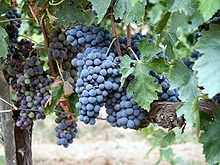
Chianti is an Italian red wine produced in the Chianti region of central Tuscany, principally from the Sangiovese grape. It was historically associated with a squat bottle enclosed in a straw basket, called a fiasco. However, the fiasco is now only used by a few makers of the wine; most Chianti is bottled in more standard-shaped wine bottles. In the latter nineteenth century, Baron Bettino Ricasoli helped establish Sangiovese as the blend's dominant grape variety, creating the blueprint for today's Chianti wines.

Barolo is a red denominazione di origine controllata e garantita (DOCG) wine produced in the northern Italian region of Piedmont. It is made from the nebbiolo grape and is often described as one of Italy's greatest wines.

Sangiovese is a red Italian wine grape variety that derives its name from the Latin sanguis Jovis, "the blood of Jupiter". Though it is the grape of most of central Italy from Romagna down to Lazio, Campania and Sicily, outside Italy it is most famous as the only component of Brunello di Montalcino and Rosso di Montalcino and the main component of the blends Chianti, Carmignano, Vino Nobile di Montepulciano and Morellino di Scansano, although it can also be used to make varietal wines such as Sangiovese di Romagna and the modern "Super Tuscan" wines like Tignanello.

Brunello di Montalcino is a red DOCG Italian wine produced in the vineyards surrounding the town of Montalcino, in the province of Siena, located about 80 km south of Florence, in the Tuscan wine region. Brunello, a diminutive of bruno, is the name that was given locally to what was believed to be an individual grape variety grown in Montalcino. In 1879 the province of Siena's Amphelographic Commission determined, after a few years of controlled experiments, that Sangiovese and Brunello were the same grape variety, and that the former should be its designated name. In Montalcino the name Brunello evolved into the designation of the wine produced with 100% Sangiovese.

Italian wine is produced in every region of Italy. Italy is the world's largest wine producer, as well as the country with the widest variety of indigenous grapevine in the world, with an area of 702,000 hectares under vineyard cultivation, and contributing a 2013–2017 annual average of 48.3 million hl of wine. In 2018 Italy accounted for 19 per cent of global production, ahead of France and Spain. Italian wine is both exported around the world and popular domestically among Italians, who consume an average of 42 litres per capita, ranking fifth in world wine consumption.
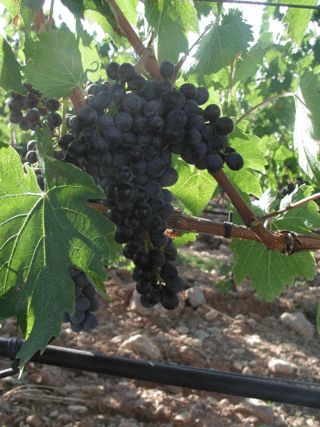
Morellino di Scansano DOCG is an Italian red wine made in the hilly environs of the village of Scansano, GR, in the Maremma region of coastal Tuscany, which has an ancient but obscure tradition of winemaking. Morellino is the local name for the Sangiovese grape variety. The wine, which was granted DOC status in 1978, then upgraded to DOCG status beginning with the 2007 vintage, is made from at least 85% Sangiovese, which is also the basis of the Tuscan wines Chianti, Brunello di Montalcino, and Vino Nobile di Montepulciano. The remaining 15% can comprise any non-aromatic black grape varieties included in a list made and periodically updated by Tuscan wine authorities.

Tuscan wine is Italian wine from the Tuscany region. Located in central Italy along the Tyrrhenian coast, Tuscany is home to some of the world's most notable wine regions. Chianti, Brunello di Montalcino and Vino Nobile di Montepulciano are primarily made with Sangiovese grape whereas the Vernaccia grape is the basis of the white Vernaccia di San Gimignano. Tuscany is also known for the dessert wine Vin Santo, made from a variety of the region's grapes. Tuscany has forty-one Denominazioni di origine controllata (DOC) and eleven Denominazioni di Origine Controllata e Garantita (DOCG). In the 1970s a new class of wines known in the trade as "Super Tuscans" emerged. These wines were made outside DOC/DOCG regulations but were considered of high quality and commanded high prices. Many of these wines became cult wines. In the reformation of the Italian classification system many of the original Super Tuscans now qualify as DOC or DOCG wines but some producers still prefer the declassified rankings or to use the Indicazione Geografica Tipica (IGT) classification of Toscana. Tuscany has six sub-categories of IGT wines today.

Ornellaia is an Italian wine producer in the DOC Bolgheri in Toscana, known as a producer of Super Tuscan wine. Ornellaia is considered one of Italy's leading Bordeaux-style red wines. The estate also produces a second wine, Le Serre Nuove, the blend Le Volte, the Merlot-labeled varietal wine Masseto, in addition to estate production of grappa and olive oil. In 2012, the winery's name was changed from "Tenuta dell'Ornellaia" to "Ornellaia e Masseto", in recognition of the increasing importance of the Merlot-based wine.
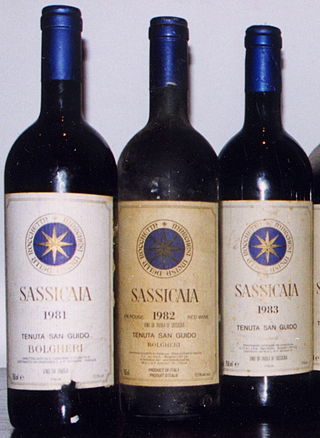
Tenuta San Guido is an Italian wine producer in the DOC Bolgheri in Toscana, known as a producer of "Super Tuscan" wine. It produces Sassicaia, a Bordeaux-style red wine. The estate also produces a second wine, Guidalberto, and a third wine, Le Difese. Tenuta San Guido is member of the Primum Familiae Vini.
Franco Ziliani is an Italian journalist, blogger and wine critic, with a specialty in Italian wines since 1985. He has contributed to several periodicals including Decanter, A Tavola, Barolo & Co. and Merum, Il Corriere Vinicolo, De Vinis, The World of Fine Wine, as well as a column for Harpers Magazine with Nicolas Belfrage MW with whom he has also contributed to Tom Stevenson's annual Wine Report. Ziliani and Jeremy Parzen launched VinoWire.com in March 2008, to provide an English language news service on the subject of Italian wine. Ziliani has since been credited by La Repubblica with first breaking the 2008 Brunello scandal.

Gaja is an Italian wine producer from the Piemonte region in the district of Langhe, chiefly producing a number of Barbaresco and Barolo wines, and later diversified into Brunello di Montalcino and "Super Tuscan" production. Its current owner and president Angelo Gaja is credited with developing techniques that have revolutionised winemaking in Italy, and terms such as "the undisputed king of Barbaresco", and "the man who dragged Piedmont into the modern world" have been applied to him, and whose Barbaresco wine is considered a status symbol on a par with Château Lafite Rothschild or Champagne Krug.
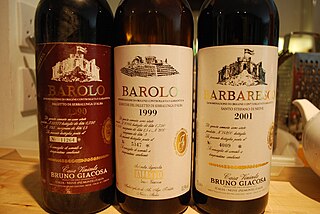
Bruno Giacosa was an Italian wine producer from the village Neive in the Langhe region (Piemonte), who produced a number of Barbaresco and Barolo wines, as well as bottlings of Arneis, Barbera, Dolcetto and a sparkling wine. Wines produced from owned vineyards are bottled under the label Azienda Agricola Falletto , wines from bought grapes or from grapes from leased vineyards under the label Casa Vinicola Bruno Giacosa. In terms of the production of Nebbiolo, Giacosa was considered a traditionalist. He has been described as the "Genius of Neive".
Fiorano was an Italian wine-producing estate owned by Alberico Boncompagni Ludovisi, a prince of Venosa of the Ludovisi family, active during a period from the late 1940s to 1995. Fiorano is situated in the vicinity of Rome near the Via Appia Antica in the Latium district. Famed wine writer Burton Anderson dubbed Fiorano's wines 'the noblest Romans of them all' in his 1980 anthology Vino. The estate, its methods, wines and its proprietor were all noted for their unorthodoxy in comparison to norms of the wine industry. Though limited in terms of fame, the red wine and two white wines produced at Fiorano during its period of activity achieved reputations for innovation and longevity. Since the late 1960s a small number of devout 'cognoscenti', especially among restaurant owners in Rome, knew about the extraordinary qualities of the two whites Fiorano Bianco and Fiorano Riserva Semillon, and overcame numerous obstacles in order to get the wines.

Azienda Agricola Case Basse di Gianfranco Soldera, commonly referred to as Case Basse or Soldera, is an Italian wine producer located in Montalcino, Tuscany, producing highly priced wine declared under DOCG Brunello di Montalcino. It was owned by Gianfranco Soldera from 1972 until his death on February 16, 2019, at age 82.
Burton Anderson is an American writer. A native of Minnesota, he is the former editor of the International Herald Tribune in Paris. He lives in Italy and writes about wine, food, and travel. The New York Times called him "the leading authority on Italian wines writing in English."
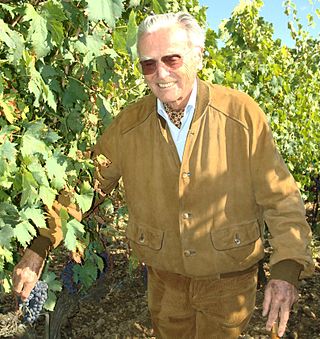
Franco Biondi Santi was an Italian winemaker, most known for producing Brunello di Montalcino, a red wine produced only in Montalcino, Tuscany.

Kerin O'Keefe is a wine critic specialized in Italian wine and author of four books. She reviews wines and writes articles on the growing areas, wines and producers for kerinokeefe.com.
Countess Noemi Marone Cinzano is an Italian businessperson. A wine personality, she is known for owning many well established vineyards and Cinzano Glass. Her flagship wine is considered to be Noemía de Patagonia.
Castiglion del Bosco is a wine estate which produces Brunello di Montalcino and was one of the founders of Brunello di Montalcino Consortium. It is located in the comune of Montalcino in the province of Siena, Italy, within the Val d’Orcia nature reserve, a UNESCO World Heritage Site.

